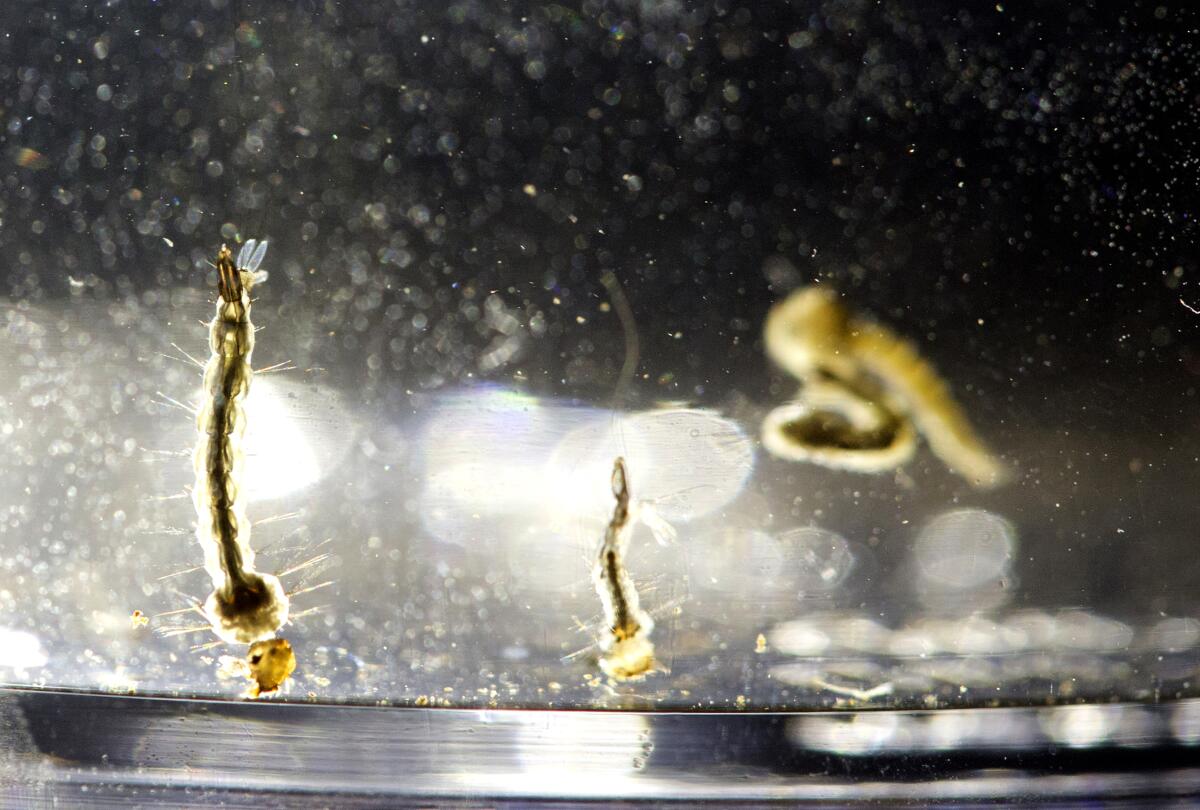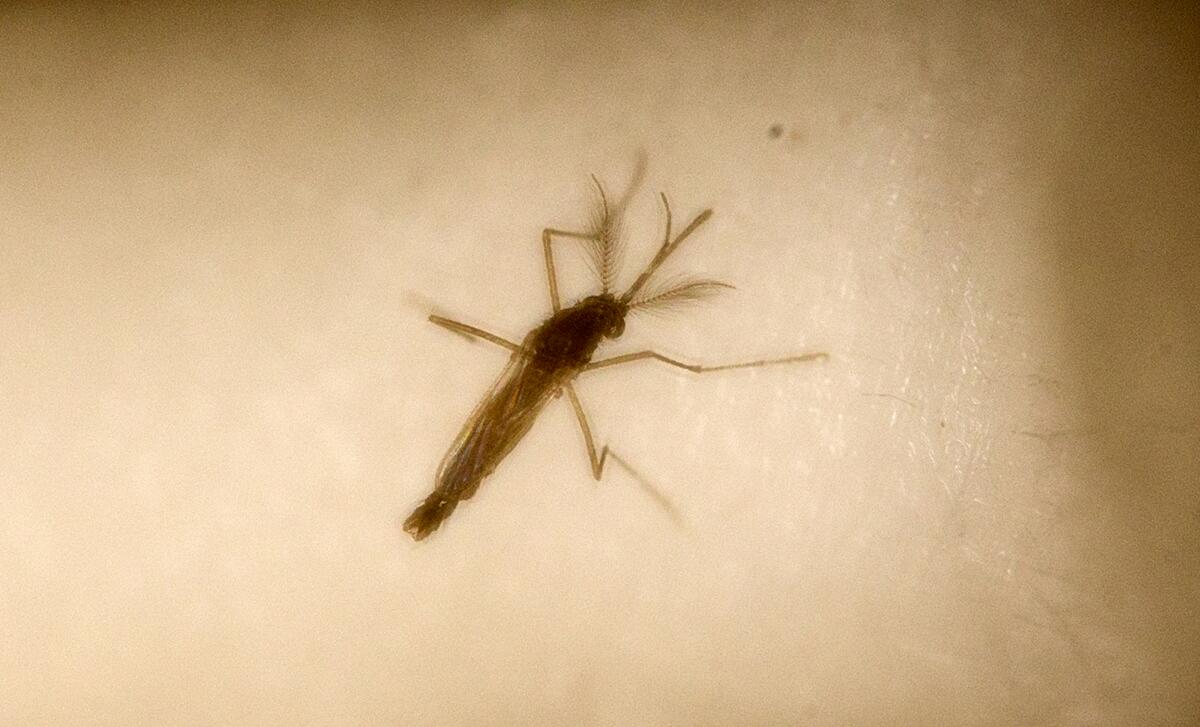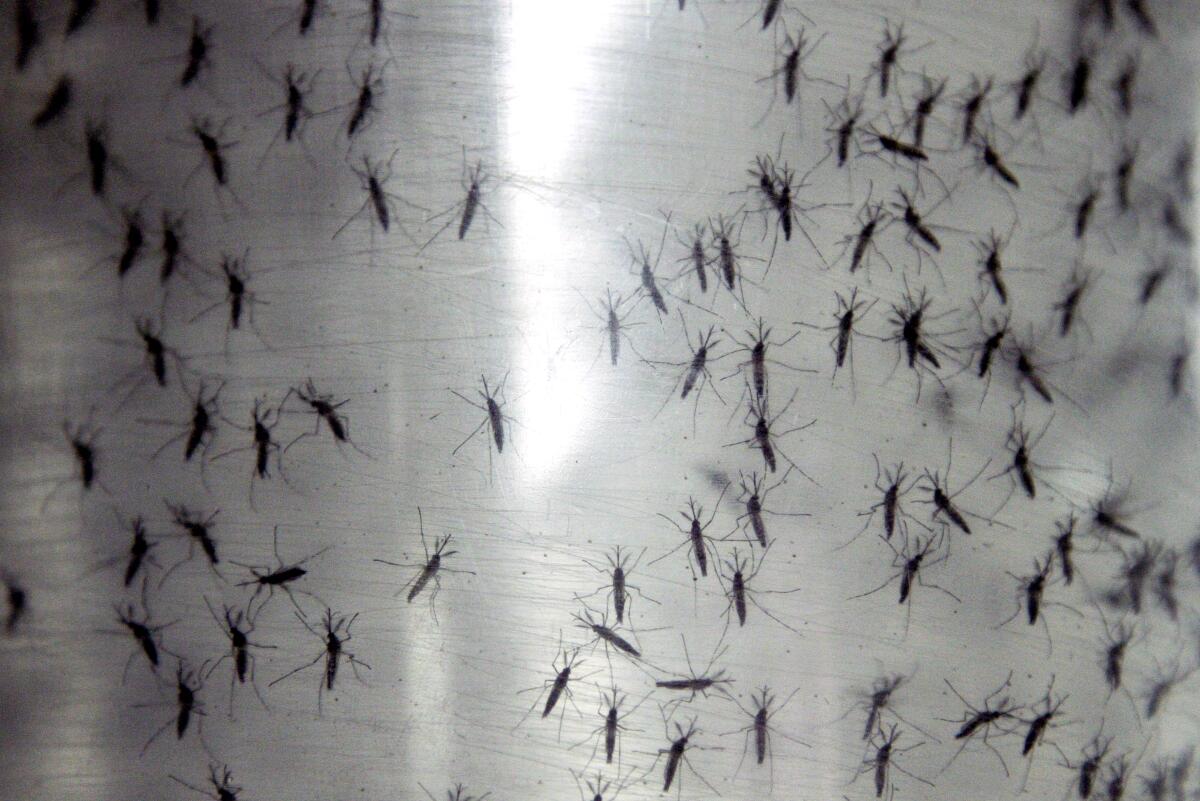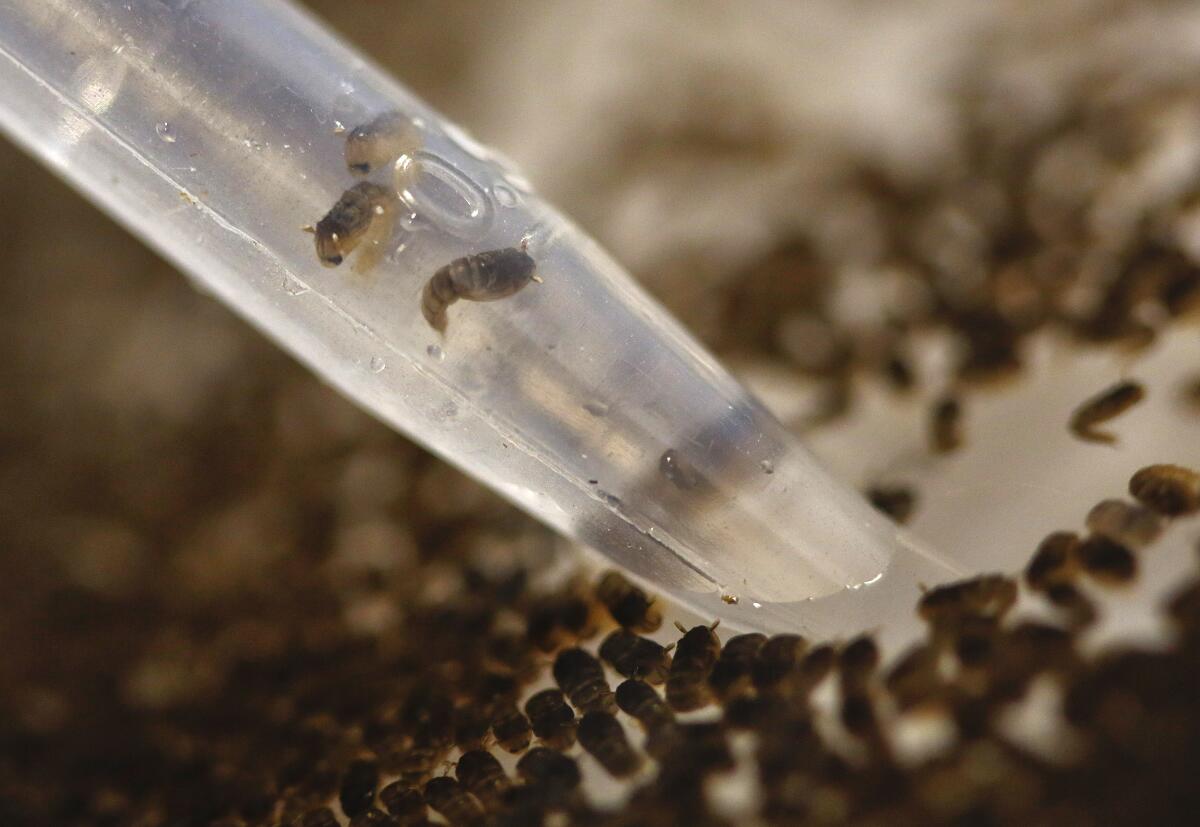In California, an army of genetically engineered mosquitoes awaits release. Will it backfire?

In the mosquito breeding rooms of British biotech company Oxitec, scientists line up fresh eggs, each the size of a grain of salt. Using microscopic needles, the white-coated researchers inject each egg with a dab of a proprietary synthetic DNA.
For four days, Oxitec technicians care for the eggs, watching for those that hatch into wriggling brown larvae. Those “injection survivors,” as the company calls them, face a battery of tests to ensure their genetic modification is successful.
Soon, millions of these engineered mosquitoes could be set loose in California in an experiment recently approved by the federal government.
Oxitec, a private company, says its genetically modified bugs could help save half the world’s population from the invasive Aedes aegypti mosquito, which can spread diseases such as yellow fever, chikungunya and dengue to humans. Female offspring produced by these modified insects will die, according to Oxitec’s plan, causing the population to collapse.
“Precise. Environmentally sustainable. Non-toxic,” the company says on its website of its product trademarked as the “Friendly” mosquito.
Scientists independent from the company and critical of the proposal say not so fast. They say unleashing the experimental creatures into nature has risks that haven’t yet been fully studied, including possible harm to other species or unexpectedly making the local mosquito population harder to control.
Even scientists who see the potential of genetic engineering are uneasy about releasing the transgenic insects into neighborhoods because of how hard such trials are to control.
“There needs to be more transparency about why these experiments are being done,” said Natalie Kofler, a bioethicist at Harvard Medical School who has followed the company’s work. “How are we weighing the risks and benefits?”
She pointed out that the possible benefits of the technology in California are lower than they would be in more tropical regions of the world where mosquito-borne disease outbreaks often threaten humans. California has never had a case in which an Aedes aegypti was found to transmit disease.

Nathan Rose, Oxitec’s head of regulatory affairs, said the company chose California because the Aedes aegypti mosquitoes have spread rapidly after being discovered in the state about a decade ago. The tiny, aggressive day-biters can lay eggs in a space as small as a water-filled bottle cap left in the backyard.
Rose noted that the company found its mosquito reduced the population in a Brazilian neighborhood by 95% in just 13 weeks.
So far, Oxitec has released little of its data from that experiment or from a more recent release in the Florida Keys. It hasn’t yet published any of those results in a peer-reviewed scientific journal — publications that scientists expect when evaluating a new drug or technology.
The drug Makena doesn’t reduce the risk of preterm birth, a study found, and the FDA recommended it be taken off the market. Its maker has refused.
On March 7, the U.S. Environmental Protection Agency announced that it had granted Oxitec a permit to release its transgenic insects on 29,400 acres in the counties of San Bernardino, Fresno, Stanislaus and Tulare.
The company plans to start the release in northern Tulare County in the Central Valley, where it has partnered with the local mosquito control district based in the city of Visalia.
The experiment must still be approved by the state Department of Pesticide Regulation.
Inserting synthetic DNA into mosquitoes
To create its mosquito, known as the OX5034, Oxitec started with Aedes aegypti captured in Mexico’s Chiapas state. Its scientists then inserted into the insects a synthetic DNA sequence they call the “self-limiting” gene.
When the engineered male mosquitoes are released into neighborhoods and mate with the wild bugs, the gene works to kill the female offspring, Oxitec said. The male progeny fly away to mate with more of the local mosquito population, further spreading the company’s gene, which it says is lethal only to the Aedes aegypti and not other species.
The company said that because it is releasing only males there is no danger of the public being bitten by an engineered insect. Only female mosquitoes bite and carry disease.
Oxitec scientists also inserted a fluorescent marker gene into the modified bugs. That gene produces a protein to make its mosquitoes glow when exposed to a specific color of light so that the company can track them.

The company plans to use the data from the California experiment to try to gain full commercial approval of its engineered mosquitoes from the EPA — a goal that would substantially increase the private company’s value. It uses the same technology in myriad other invasive pests, including the fall armyworm and the soybean looper, which it hopes to sell in the U.S. and around the world.
Oxitech is owned by Third Security, a private company in Virginia founded by billionaire Randal J. Kirk. The former lawyer became wealthy through founding and investing in pharmaceutical companies. He received more than $1 billion in 2007 when his company New River Pharmaceuticals and its attention deficit disorder drug called Vyvanse were purchased by Shire.
More recently, Kirk has focused on experimental products created through genetic engineering. Another of his investments is the genetically modified salmon created by the company AquaBounty to grow faster with less food. AquaBounty is now farm-raising the modified fish for commercial sale at facilities in Indiana and on Prince Edward Island.
Experiment in the Central Valley
When it comes to the environment, growing modified fish inside a factory raises different issues than releasing winged experimental creatures into the wild, which the company hopes to do soon in Tulare County if state regulators agree.
Oxitec has proposed releasing its mosquitoes at 48 different locations in the county. Under the plan, the company said it would release a maximum of 3.5 million mosquitoes a week.
“This is alarming,” said Angel Garcia, who lives near Visalia, where the first engineered bugs may be released. “Residents have not been consulted and they have not consented to being part of this.”
Garcia, who does outreach to local residents as part of his job for the nonprofit group Californians for Pesticide Reform, pointed to a hiring event that Oxitec hosted in Visalia on March 17. A company flyer said it was hiring field and lab technicians.
“It’s as if this is already a done deal,” he said.
Rose told The Times that the company was still waiting for state approval while also continuing with plans to build a research facility in Visalia to aid in the work.
State officials said they plan “a rigorous scientific evaluation” of the company’s proposal that will take at least several months to complete. They said public comments can be emailed to [email protected] until April 19.
Most people don’t buy a home with a 20% down payment. Here’s how you can put down less and get more help with down payment and closing costs.
Among scientists’ concerns is that releasing the genetically modified mosquitoes into neighborhoods could create hybrids that are hardier and more dangerous to humans than the state’s current population.
The EPA said it had reviewed a 2019 study led by researchers at Yale who found that DNA from the Oxitec bugs had been transferred to the local mosquito population in an area of Brazil — raising questions of whether the experiment had unintentionally created hybrids that were more robust. When that study was published, Oxitec complained that the researchers had exaggerated their findings, and the journal’s editors later added a note to the article that some of the language may have been misleading.
EPA regulators agreed that what the Yale scientists had found — the transfer of DNA from the corporate-created mosquitoes to the wild population, which is called introgression — was a concern. They said the probability of this happening with the OX5034, the strain of bugs the company wants to release in California, was “likely to be significantly higher” than what the Yale study had found with an earlier generation, according to a memo written by EPA scientists.
Rose said Oxitec expected the introgression. He said the company had designed its mosquitoes so that their DNA soon disappeared from the wild population. That happens, he said, because not only do the mosquitoes with the company’s genes have female offspring that die, but they are also more vulnerable to chemical insecticides than the Aedes aegypti now in California.
An EPA spokesperson said regulators expected that mosquitoes with the corporate genes “would disappear from the environment within 10 generations of mosquitoes because they are not able to reproduce as successfully as local populations.”
To prove this, the agency has required Oxitec to monitor neighborhoods for mosquitoes that have DNA from its engineered insects until none have been found for at least 10 consecutive weeks.
The Central Valley’s large agriculture industry poses another risk for the experiment because of farmers’ use of antibiotics on citrus groves and in livestock.

Oxitec uses the antibiotic tetracycline to raise its bugs and mass produce them. When larvae of its modified mosquitoes are exposed to tetracycline, the females — which bite humans — can survive.
Because of the risk posed by the antibiotic, the EPA required Oxitec not to release its mosquitoes within 500 meters of any commercial citrus grove, livestock facility or human waste treatment plant.
The agency also required Oxitec to search for any female mosquitos that survive and alert regulators if any are found. The EPA said it could shut down the experiment if problems are found.
The EPA added that it believed the release would have “no discernible effects” on endangered species or other wildlife including birds, bats or fish.
Technology and regulation
Through genetic engineering, scientists have gained increasing powers to reshape nature. Already, modified crops such as glyphosate-resistant corn are common in American fields, making farming easier and earning huge profits for their corporate developers.
But as the science grows more complex and moves from plants to animals, some scientists worry that regulators are overmatched. They fear the EPA’s regulations are not strong enough to protect the public and the environment.
“We are concerned that current government oversight and scientific evaluation of GM mosquitoes do not ensure their responsible deployment,” Kofler and four other academic scientists wrote in 2020 soon after Oxitec proposed its first release in Florida.
As many white-collar employees enter a third year of working from home, lawsuits demanding reimbursement for home-office expenses are on the rise.
The group detailed how the EPA was reliant on internal data from the biotech companies in making its decisions. That data could be biased, they said, because the companies have a conflict of interest since they could profit if the technology is approved.
Instead, EPA scientists should seek the opinion of independent experts to help decide whether to approve the products, they wrote.
The EPA spokesperson said that the agency had policies to ensure the corporate data “represent sound science” and that it had sought advice from other sources before approving Oxitec’s California trial.
Kofler said the group worried that the EPA was “getting caught a little flat-footed.”
“It’s not a modern enough regulatory structure,” she said, “for a very modern and complicated technology.”
More to Read
Inside the business of entertainment
The Wide Shot brings you news, analysis and insights on everything from streaming wars to production — and what it all means for the future.
You may occasionally receive promotional content from the Los Angeles Times.














